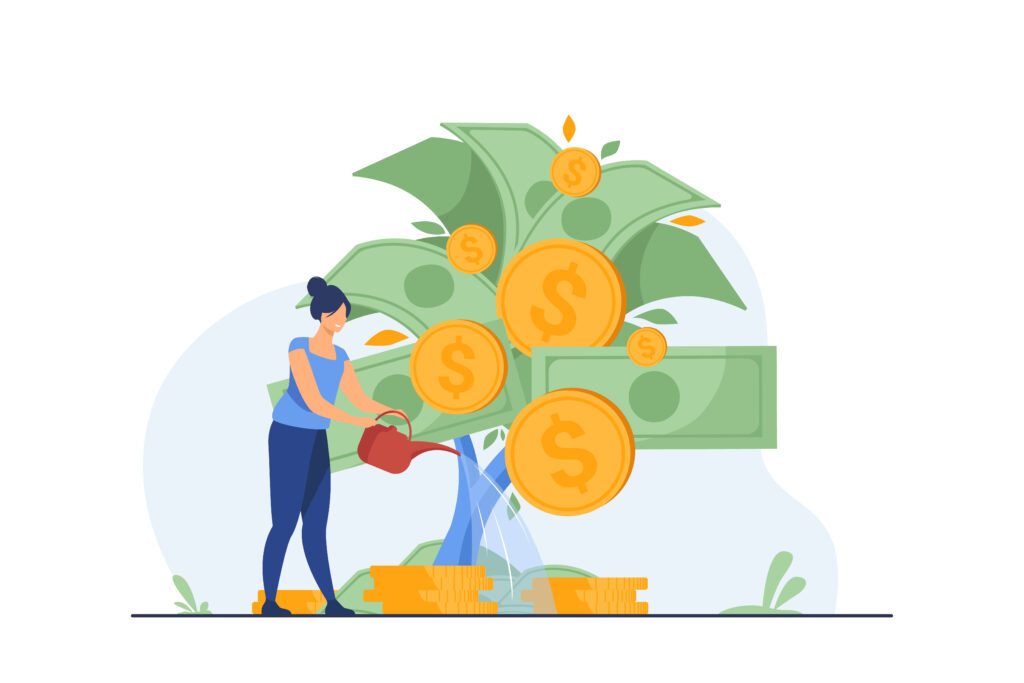Here’s a list of ways you can invest money to grow wealth over time. Each method includes simple explanations, potential outcomes, and suggestions on where to start:
1. Stock Market Investing
- What it is: Buying shares in publicly traded companies to earn dividends and benefit from price appreciation.
- Potential Outcome: High returns over the long term, but it comes with short-term volatility.
- Where to Start: Platforms like E*TRADE, Robinhood, Fidelity, or Vanguard for individual stocks or ETFs.
2. Index Funds & ETFs
- What it is: Investment funds that track the performance of a market index like the S&P 500.
- Potential Outcome: Steady, long-term growth with lower risk than individual stocks.
- Where to Start: Vanguard, Schwab, BlackRock (iShares).
3. Real Estate
- What it is: Buying property to earn rental income or profit from value appreciation.
- Potential Outcome: Passive income and long-term value increase.
- Where to Start: Look into property investment platforms like Fundrise or contact local real estate agents.
4. Mutual Funds
- What it is: A pooled investment managed by professionals, typically diversified across various assets.
- Potential Outcome: Moderate growth with less involvement required from the investor.
- Where to Start: Fidelity, Vanguard, or T. Rowe Price.
5. Bonds
- What it is: Lending money to governments or corporations in exchange for regular interest payments and repayment of principal.
- Potential Outcome: Low-risk, steady income, but lower returns compared to stocks.
- Where to Start: TreasuryDirect (for U.S. government bonds) or brokerage firms for corporate bonds.
6. High-Interest Savings Accounts or CDs (Certificates of Deposit)
- What it is: Parking money in accounts with higher interest rates than regular savings or locking it in for a set period with CDs.
- Potential Outcome: Safe and predictable growth, ideal for short-term goals.
- Where to Start: Online banks like Ally, Marcus by Goldman Sachs, or your local bank.
7. Peer-to-Peer Lending
- What it is: Lending money to individuals or small businesses via online platforms, earning interest over time.
- Potential Outcome: Higher returns than savings accounts but risk of borrower default.
- Where to Start: Platforms like LendingClub or Prosper.
8. Retirement Accounts (401(k), IRA)
- What it is: Tax-advantaged accounts for long-term savings and investments.
- Potential Outcome: Significant growth over decades due to tax benefits and compound interest.
- Where to Start: Talk to employers for a 401(k) or financial institutions like Fidelity or Charles Schwab for an IRA.
9. Invest in a Business or Start One
- What it is: Using money to create or buy a business that generates income.
- Potential Outcome: High returns, but it requires effort and risk tolerance.
- Where to Start: Look for franchises, or explore opportunities through sites like Shopify for e-commerce.
10. Cryptocurrency
- What it is: Investing in digital currencies like Bitcoin, Ethereum, or other blockchain assets.
- Potential Outcome: High-risk but potentially high-reward investments. Volatile market.
- Where to Start: Platforms like Coinbase, Binance, or Kraken.
11. Precious Metals (Gold, Silver)
- What it is: Buying physical metals or investing in ETFs backed by metals.
- Potential Outcome: A hedge against inflation and economic uncertainty.
- Where to Start: Dealers like JM Bullion, APMEX, or ETFs like SPDR Gold Shares.
12. Invest in Yourself (Education & Skills)
- What it is: Using money to improve knowledge or skills that increase earning potential.
- Potential Outcome: Long-term career growth and higher income.
- Where to Start: Platforms like Coursera, Udemy, or LinkedIn Learning.
13. REITs (Real Estate Investment Trusts)
- What it is: Investing in companies that own income-generating real estate.
- Potential Outcome: Earn dividends without directly managing properties.
- Where to Start: Vanguard REIT Index Fund, Realty Income Corp.
14. Dividend Stocks
- What it is: Stocks from companies that regularly share profits as dividends.
- Potential Outcome: Passive income plus potential stock value growth.
- Where to Start: Research dividend aristocrats and platforms like Robinhood or TD Ameritrade.
Here is our advice on investments
One of the best ways to grow wealth over time is by starting an investment portfolio with platforms like Vanguard or Fidelity. A great strategy is to invest in S&P 500 index funds and REITs (Real Estate Investment Trusts). These two types of investments have historically provided strong returns and can also pay you dividends.
You can split your investments into a ratio that works for you, such as 70% S&P 500 and 30% REITs, or 50/50—it’s your choice depending on your comfort level. On average, these investments could provide a return of around 8–11% annually, including dividend payouts.
Here’s why this is powerful:
By consistently investing a fixed amount every month, your money grows not only from what you invest but also from the compound interest effect. Over time, the dividends you earn can be reinvested to buy more shares, accelerating your portfolio’s growth.
Example: Investing $200 Per Month
Let’s say you invest $200 every month into a portfolio split between the S&P 500 and REITs. If you average an annual return of 10%, here’s how your money could grow:
- After 10 years: Your portfolio would grow to approximately $38,700.
- After 20 years: Your portfolio would grow to around $151,000.
- After 30 years: Your portfolio would grow to about $545,000.
These numbers assume you consistently invest and reinvest dividends, allowing compound interest to work its magic.
How Does This Help You Become Financially Independent?
Once your portfolio grows to a significant amount, the dividends alone can generate passive income. For example, if your portfolio grows to $1,000,000 and earns a 10% dividend yield, you’ll receive $100,000 per year in dividends.
If you don’t need to withdraw all the income, you can reinvest some of it to continue growing your wealth. Over time, you can even stop adding your own money and let your portfolio self-sustain and grow on its own.
The Long-Term Perspective
While this method requires patience (typically 10–30 years), the results are life-changing. Time flies, and by investing consistently, you set yourself up for financial independence. Many people use this strategy to retire early, live off dividends, and still leave wealth behind for future generations.
This strategy is not a get-rich-quick scheme, but it is one of the safest, most reliable ways to build long-term wealth. The earlier you start, the better, as compounding works best when it has time to grow.
Do you like this? Read also our other articles:
What is the law of attraction?



